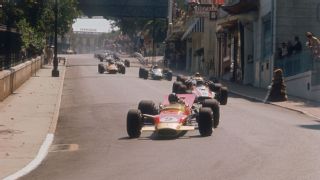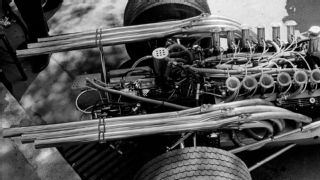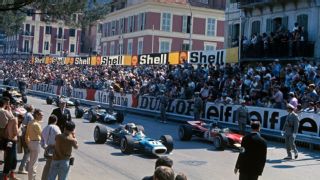|
When Free Practice 1 started on the dot of 11 a.m. Thursday in Monaco, it was a surprise to no one. This was the beginning of a carefully orchestrated timetable running throughout the weekend. Along with the entry list, the F1 schedule was carried in the official programme and published in local newspapers. It wasn't always like that. Fifty years ago this weekend, when I made my first visit to the Monaco Grand Prix on a coach trip from London, the race appeared to run despite itself. Which, in the more relaxed times of 1968, was also a surprise to no one. The official programme stated that Thursday's practice was due to run from 2 p.m. until 3:30 p.m. They might as well have warned the locals that there might be a bit of undue noise after lunch, but not to worry about it. During the first 30 minutes or so, there was the occasional bark of an engine revving in the pits but precious little else. A couple cars eventually appeared and completed a perfunctory lap, and then all was silent once more. We could see people hanging around in the pits (then edging the start/finish straight). It was as if no one was particularly bothered.  Such an anticlimactic start was in keeping with the feeling of huge disappointment when Enzo Ferrari, for no apparent reason, chose not to make the 280-mile (450 km) journey from Maranello. Chris Amon might have been on pole at the previous race at Jarama, but a failure by both Amon and Jacky Ickx to finish in Spain, coupled with appalling memories of Lorenzo Bandini's fatal accident at Monaco's harbour chicane 12 months before, had prompted Ferrari to stay at home. Simply because he could. These were tough days for F1 spectators, particularly those of us still reeling from the loss of our hero, Jim Clark, just six weeks before. Jackie Stewart, suffering a wrist injury sustained in an F2 race, would be a nonstarter. As would the BRM to be driven by Chris Irwin, the promising Englishman who was badly hurt during the Nürburgring 1000 kms sportscar race the weekend before. Monaco had been planned several months previously as the highlight of our year; this was threatening to be anything but. No one seemed to know who was running or when. There was even a hint of rain. Then the weekend simply took off. A damp track on Friday morning provided a canvas for the unexpected brilliance of the relatively unknown Johnny Servoz-Gavin. Stewart's temporary replacement gave spectators a huge buzz -- and Ken Tyrrell palpitations -- by power-sliding the Matra-Ford V8 within millimetres of the kerbs (there were very few barriers in 1968). The same went for the permanently sideways Jochen Rindt in his Brabham, not to mention the incredibly brave Jean-Pierre Beltoise, opposite-locking the bulky works Matra with its V12 shrieking through six long exhaust pipes made of chrome.  We felt we were already on speaking terms with the little French man and his light blue car. He had brought our breakfast in the Hotel Europe (long since demolished in favour of a tall apartment block) to a premature halt. Over the clatter of coffee cups and the crunching of baguettes, we heard the urgent call of a multicylinder engine somewhere in the near distance. Running up what was to become the escape road for Mirabeau and down the hill toward what was then known as Station Hairpin, we followed the sound onto a road along a former railway line where the Fairmont Hotel now sits. This being Matra's debut with the V12, they wanted to run the car, so the police simply closed the road. As you do. Beltoise -- wearing jeans and moccasins, with a flameproof top pulled over a casual shirt -- then blasted up and down to his heart's content. The sound, ricocheting around the buildings and rock face, was simply incredible. Once that was done, Jean-Pierre climbed from the car, pulled off his helmet and stood chatting as though he had just arrived from Menton, parked up and was about to go shopping. Informality was the watchword. There was no paddock as such, with teams setting up in various garages around town. By good fortune, McLaren were working from lock-ups beneath our hotel, in which Bruce, Denny Hulme and the mechanics (about six in total) were also staying. We spent hours by the garage doors, watching and listening as the lads prepared and discussed the weekend. McLaren became 'our' team as we nodded at breakfast and gave a thumbs-up in the lobby after 'we' qualified seventh and 10th.  Servoz-Gavin, remarkably, was on the front row alongside Graham Hill's pole position Lotus-Ford. The dashing Frenchman with the blond locks actually led, which gave Tyrrell further palpitations, particularly when Johnny ignored Ken's advice to stay cool as he pulled out three seconds in as many laps before retiring with transmission terminally damaged against a kerb. Hill won for the fourth time, the first driver to do so. Following prize-giving in the Hotel de Paris, Graham and his wife, Bette, walked down the hill to the Tip Top bar and joined the throng of team members, officials and fans. Les Leston, a former racer, was paying out after running his annual book with drivers' odds chalked on a board at the back of the bar. Fancying a long shot, I had put a couple of French Francs on Rindt and Pedro Rodriguez. The Brabham and the BRM had finished in the wall. Beltoise lasted 11 laps before hitting the chicane. McLaren came off even worse when he spun in the tunnel on the opening lap. Hulme had come home fifth. That would be cause for celebration today. Back in 1968, the result was tempered with the thought that he had finished last of the runners, seven laps down after stopping to change a drive-shaft coupling. The pit stop took almost 11 minutes. Different times. In every sense.
|
